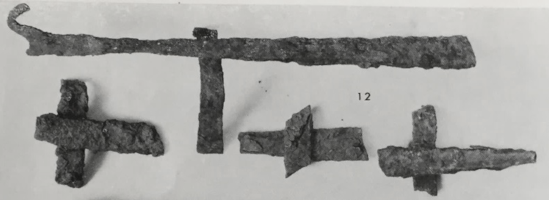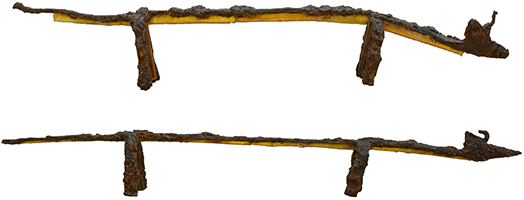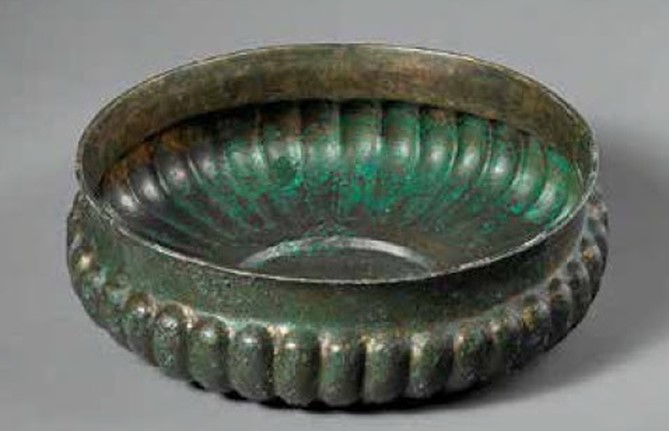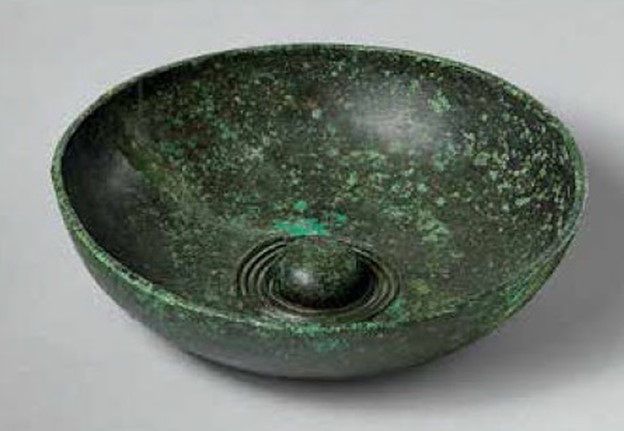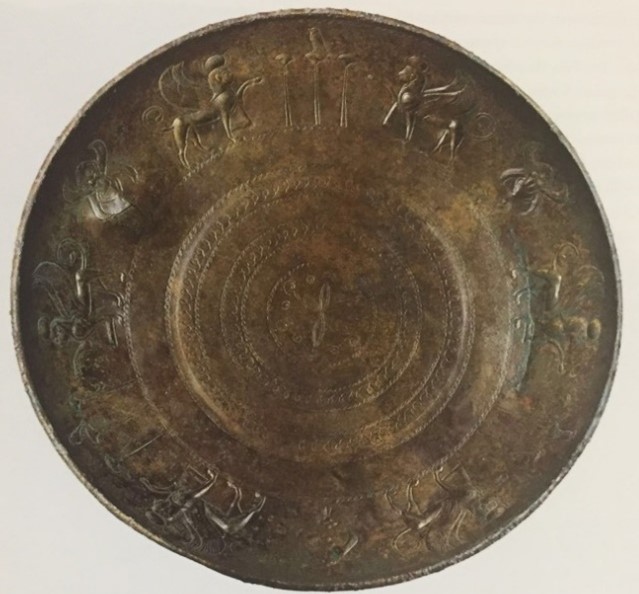The firedogs are quite deformed in their current state. The bow is rectangular and appears to have a double stepped forecastle similar to the Dipylon ships. The other major difference from the other ship-shaped firedogs is the presence of an aftercastle triangular in shape. The horns of both posts are incurving similar to the other known examples.
Ship-shaped iron fire-dogs
A49
9th century BC
Eleutherna T. A1K1, Orthi Petra/ Eleutherna necropolis
A pair of iron fire-dogs, each resting on two stands riveted at right angles to the ship's body
Agelarakis 2016 (cremation remains); Haarer 2000: 29; Kotsonas 2008 (tomb); Stampolidis 1994: 107, no. 58; 2004: 284, nos. 366-367; 2014: 284-90; Stampolidis and Karetsou 1998: 258-59, no. 323; Vonhoff 2011: 146, 148, fig. 11
This collective chamber tomb was used extensively from the LPG to the EO periods (early 9th to late 7th or early 6th centuries BC) to house cremation urns and their burial offerings. The strength and extent of the cremations was thorough, reaching very high temperatures of 900o C or more. Once the cremation was complete, cremated bone elements were carefully and methodically recovered to be placed inside the urn in a specific order to replicate a seated or upright anatomical position. Osteological evidence of 141 individuals representing some 11 generations indicates that the occupants were adults and predominantly male (75%). These show considerable bone robustness with very emphasized muscular imprints, indicating that the majority of the males buried there were in an exceptional physical condition which would have required daily strenuous activities to develop and maintain (Agelarakis 2006: 4). Evidence of injuries further supports the suggestion of a warrior occupation.
The unlooted tomb has provided exceptionally rich burial gifts, including numerous bronzes considering that cinerary urns were often covered with a bronze vessel. Burial gifts inside the urns include jewellery, perfume and faience vases, iron and bronze weapons, while larger vessels and tools were placed next to the urns. Of the documented pottery assemblage comprising some 400 vessels, 52 vases are imported (13%). These were all located inside the chamber tomb and include pots from other Cretan sites (notably Knossos), the Saronic Gulf (Corinthia, Attica), the Cyclades, and East Greece, Cyprus, and the Levant. The Cypriot and Levantine connection is better represented by non-ceramic objects, such as beads, faience vessels, bronze vessels, and a bronze shield.
The discovery of three Phoenician stone monuments (cippi) at Orthi Petra and two more from Knossos confirms that Phoenicians were living at some Cretan communities in the late 8th and 7th centuries and were sufficiently integrated to be allowed burial in typical Phoenician form next to Cretan burials. In addition to the iron ship-shaped firedogs the tomb contained five iron obeloi of a type not known from Cyprus, square in section with trapezoidal handles. The difficult stratigraphy makes their association with a specific urn problematic, although the presence of weapons and the osteological evidence is in line with the warrior burials that were furnished with the barbecue kit elsewhere.
Agelarakis, A. P. 2016. A Dignified Passage through the Gates of Hades: The Burial Custom of Cremation and the Warrior Order of Ancient Eleutherna. Oxford: Archaeopress.
Haarer, P. 2000. Obeloi and Iron in Archaic Greece. DPhil. University of Oxford.
Kotsonas, A. 2008. The Archaeology of Tomb A1K1 of Orthi Petra in Eleutherna: The Early Iron Age Pottery. Heraklion: University of Crete.
Stampolidis, N. C., (ed.) 2004. Eleutherna: Polis – Acropolis – Necropolis. Exhibition at the Museum of Cycladic Art, 1.12.2004-1.9.2005. Athens: Museum of Cycladic Art.
―――. 2014. “Near Eastern Imports and Imagery on Crete during the Early Iron Age,” in J. Aruz, S.B. Graff and Y. Rakic (eds.) Assyria to Iberia at the Dawn of the Classical Age. New York: The Metropolitan Museum of Art, pp. 282-92.
Stampolidis, N. C., and Karetsou, A. (eds.) 1998. Ανατολική Μεσόγειος: Κύπρος – Δωδεκάνησα – Κρήτη, 16ος – 6ος αι. π. Χ. Herakleion: University of Crete.
Stampolidis, N.C. 1994. Ελεύθερνα. Από τη γεωμετρική και αρχαϊκή νεκρόπολη: Ταφικές πυρές και ομηρικά έπη. Rethymnon: University of Crete.
Vonhoff, C. 2011. “The Phenomenon of Feasting in Early Iron Age Cyprus. Bronze and Iron Obeloi from Cypriot Tombs as Evidence for Elite Self-Conception, Social Networks and Trans-Mediterranean Cultural Exchange Chypre,” Cahiers du Centre d'Etudes Chypriotes 41: 133-152.


